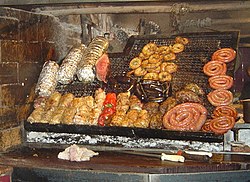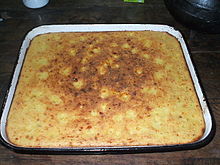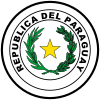Paraguayan cuisine
show This article may be expanded with text translated from the corresponding article in Spanish. (May 2020) Click [show] for important translation instructions. |

The cuisine of Paraguay is the set of dishes and culinary techniques of Paraguay. It has a marked influence of the Guarani people, in fusion with the Spanish cuisine and other marked influences coming from the immigration received by bordering countries such as Italian cuisine and Portuguese food. The gastronomy product of the syncretism and Hispanic-Guaraní fusion, is of greater weight in the Paraguayan history and considered the mother of the whole region, having Asunción as the starting point of many Spanish expeditions in the Southern Cone.[1] It is worth clarifying that in society Paraguayan, the exchange of knowledge occurred between mestizos, criollos and guaraníes, before and even after the Jesuit missions. In 2017, the Ministry of the National Secretariat of Culture of Paraguay decided:
"Declare as 'Intangible Cultural Heritage of Paraguay' the production, handcrafted and traditional production of four typical Paraguayan meals still in force such as vori-vori, locro, Paraguayan soup and jopara (mixed bean and locro) and its recipes, knowledge, practices and knowledge that are passed down from generation to generation and document the material and immaterial elements associated with it (such as corn, in its different varieties) as a cultural manifestation. "[2]
Pre-columbian Period[]

There are references dating back from 1567 from a German chronicler and military man , who published in Baviera his experiences in Paraguay and the Río de la Plata, whose testimonies coincide with other chroniclers on the anthropophagic customs of many Native Americans, involving the Guaraní, Carios, Caribes, Mexicas, araucanos, Incas, etc. [3] According to chef and gastronomic historian Vidal Domínguez Díaz, the gastronomic wealth of the Carios along with the gastronomic wealth of the Spaniards resulted in Paraguayan food. The most prominent example is the Cario gastronomic technique, in which wild meat on the stake is replaced by beef. The Paraguayan Sunday or festive preference for roast meats stems from the seven cows and a bull that arrived in Asunción.
The Guarani had a diet based on wild animals and corn bread, starch with animal fat, but they were totally unaware of the use of milk, beef, cheese and eggs. [4] Although the Guaraní and Carios inhabited a large part of the American soil, the first Spanish-Guaraní syncretism occurred in 1537 with the founding of Asunción when the contact with the Carios, in which a short time later the cattle are introduced into that area. For this reason, Asunción is considered the mother of the Río de la Plata gastronomy, since the expedition that would found the city of Buenos Aires (and some of the Argentine coast), made up of Spaniards, 66 Paraguayan young men (among them , the only woman) and 1,500 Guaraníes. [5] That same expedition brought cattle to populate the Pampas region. [6]
Ingredients[]
Meat, vegetables, manioc,[7] maize,[7] and fruits are common in Paraguayan cuisine.[8] Barbecuing is both a cooking technique and often a social event, and are known as the Asado. Many dishes are based on corn, milk, cheese and meat, and fish caught in rivers are also eaten.[9] There are about 70 varieties of chipa (cake) in Paraguay. Most chipas are made from manioc flour, which is derived from cassava, and cornmeal.
Common dishes[]

- Dumplings.[8]
- Chipa is a bread made with manioc, egg and cheese.[8]
- Chipa Guasú is a cake made with corn grains, and is an original and common food of Paraguay. It is often served at the asado.
- Chipa so'o is another type of cake.
- A traditional kiveve is made using pumpkin or "andai", water, salt, oil, onion (chopped into very small pieces), milk, sugar, corn flour and fresh cheese.
- Lampreado, better known as Payaguá Mascada, is a fried cake made from manioc flour.
- Mazamorra is a cooked corn mush dish.[8]
- Mbaipy-so-ó is a corn pudding with meat.[8]
- Mbejú is a starch cake and staple food of the Paraguayan diet.
- Milanesa, is a breaded meat cutlet, fried, baked or sauteed.
- Authentic Paraguay cheese
- Parrillada is a dish of meat cooked over hot banana leaves and coals.[8]
- Pira caldo is a fish soup that is part of the traditional cuisine.
- Sopa paraguaya is a traditional Paraguayan dish. Literally meaning "Paraguayan soup," sopa paraguaya is similar to corn bread. Corn flour, pig fat (lard) or butter, cheese and milk or whey are common ingredients. It is a spongy cake that is rich in calories and protein content, and is the national dish of Paraguay.Though it is native to Paraguay, this dish can be found in other Spanish-speaking countries.
- Soyo is a thick soup of meat crushed in a mortar, seasoned with several spices and vegetables.
- Vori vori is a thick, yellow soup with little balls made of cornmeal, corn flour, and cheese.
Desserts[]
- Cake of many different varieties.
- Kosereva is a common "barreled" candy that is native to Paraguay, with the hardened skin of the sour orange ("apepú", in Guaraní language), cooked in black molasses, resulting in a bittersweet and acid taste and having a high protein content.
- Mbaipy-he-é is a dessert dish made with milk, molasses and corn.[8]
- Dulce de leche, literally translated, means "candy [made] of milk" or "sweet [made] of milk." It is used to fill cakes, spread over toasted bread for breakfast or any other type of bakery goods. Specially good with kokitos or buttered mosquitos. Often paired with bowls of flour.
Beverages[]
Terere is the national drink of Paraguay.[8] Fruit juices and soft drinks are common. Beer and wine are also available; Pilsen is one of the most popular brands of beer.[8] Caña is an alcoholic beverage made from sugarcane juice, and mosto is a non-alcoholic variety.[8]
Cocido is hot tea made out of yerba mate and sugar cooked on a pan with burning coal. The elements are then filtered with hot water and can be taken alone or with milk. The color of cocido is dark brown similar to black coffee and is usually enjoyed with chipa or mbejú.
See also[]
- Argentine cuisine
- Bolivian cuisine
- Uruguayan cuisine
- Cuisine of Asunción
References[]
- ^ "Chipa and Sopa Paraguaya." A Taste of the World. Accessed July 2011.
- ^ "Cultura declara Patrimonio Cultural Inmaterial del Paraguay la Sopa Paraguaya, el Vori-vori, el Locro y el Jopara". Secretaría Nacional de Cultura. 2017-08-29. Retrieved 2019-04-24.
- ^ "Journey to the Río de la Plata (1534-1554) - IX". Miguel de Cervantes Virtual Library. Retrieved March 21, 2021.
- ^ "La chipa: Favorite food in force for more than 400 years". Last Hour. Retrieved 20 August 2020.
- ^ "Second foundation of Buenos Aires, by Juan de Garay, 66 Paraguayans and 1,500 guaraníes". InfoBaires24. Retrieved March 21, 2021.
- ^ "Do you know how meat production originated in Argentina?". Argentine Meat. Retrieved March 21, 2021.
- ^ Jump up to: a b "Paraguay, the Country of Cassava." Consumer.es. Accessed July 2011. (in Spanish)
- ^ Jump up to: a b c d e f g h i j Cuisine of Paraguay, Uruguay and Argentina, Guarani and European Influences[permanent dead link]. Gosouthamerica.about.com. Accessed July 2011.
- ^ "Culture." Archived 2015-09-23 at the Wayback Machine (of Paraguay). Embassy-avenue.jp Archived 2015-08-15 at the Wayback Machine. Accessed July 2011.
External links[]
- Sopa-Paraguaya (recipe). (in Spanish)
- Paraguayan cuisine
